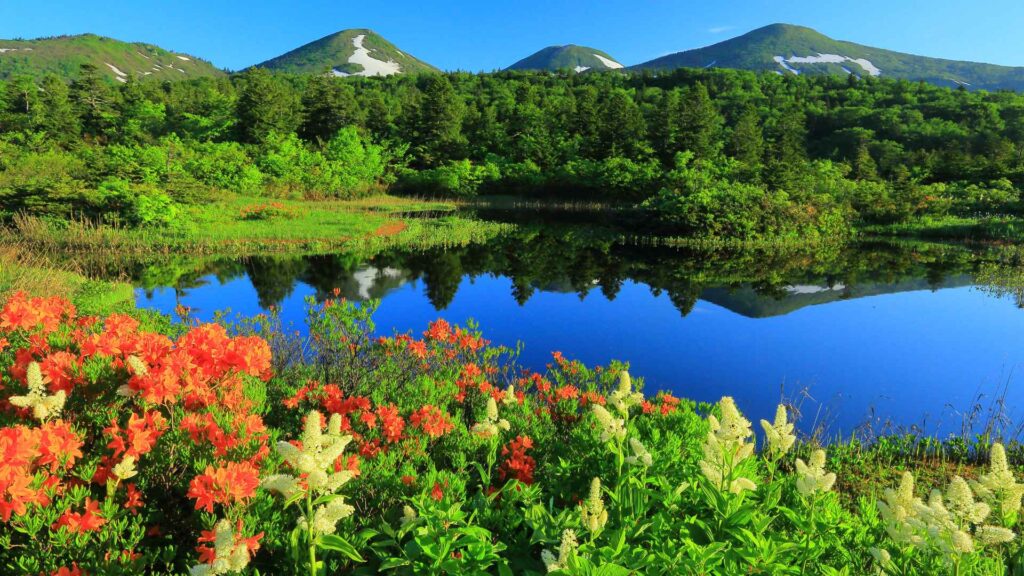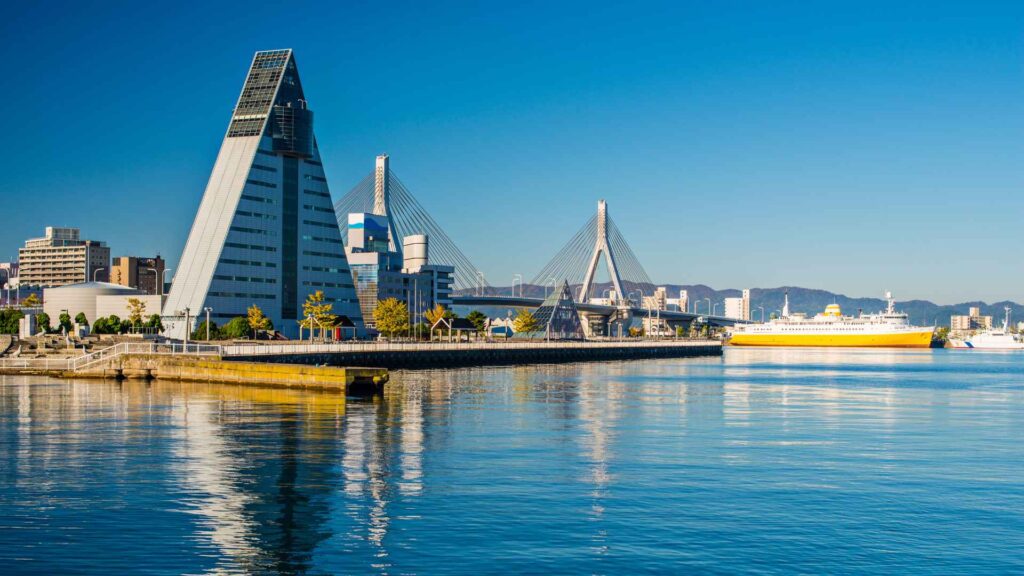Aomori Cruise Port offers a serene gateway to the natural splendor, lively traditions, and delightful flavors of northern Japan.
From vibrant festivals to fresh seafood and breathtaking landscapes, Aomori is a hidden gem brimming with unique experiences that will make your cruise stop an unforgettable journey into Japanese culture.
A Brief Overview of Aomori Cruise Port
Aomori Cruise Port serves as a tranquil arrival point for explorers venturing into the northernmost region of Japan’s main island, Honshu.
Nestled along Mutsu Bay, this port seamlessly blends modern facilities with a taste of old-world charm.
Travelers are greeted by picturesque harbor views, a refreshing sea breeze, and a warm local welcome.

Historic Background
- The Birth of a Port: Aomori’s maritime roots trace back centuries, with port activities playing a crucial role in trade and cultural exchanges between mainland Japan and neighboring Hokkaido.
- Strategic Significance: Over time, Aomori Port became a key junction for transporting goods and travelers, gradually evolving into the state-of-the-art cruise port visitors encounter today.
- Cultural Ties: Many customs, festivals, and traditions that make Aomori famous have been nurtured by the city’s seafaring heritage, from its hearty fishing culture to its intricate crafts.
Modern-Day Amenities
- Welcome Center: Travelers can find helpful resources at the cruise terminal’s welcome center, including maps, brochures, and staff ready to offer multilingual assistance.
- Transportation Links: Local buses and taxis connect the port to central Aomori, while the nearby Aomori Station provides convenient rail access to destinations throughout Japan.
- Shopping & Souvenirs: A selection of souvenir shops nearby offers handcrafted items such as Tsugaru lacquerware, Shamisen accessories, and local confectioneries.
Why Visit?
- Spectacular Scenery: Aomori boasts lush forests, rolling mountains, and pristine shores that attract nature lovers year-round.
- Cultural Festivities: Seasonal festivals, samurai history, and folk art provide an in-depth look into the region’s vibrant heritage.
- Gateway to Adventure: For travelers wishing to explore beyond the city, Aomori Cruise Port is the perfect launch pad to venture into rural Japan’s rustic charm or the enchanting Lake Towada region.
With a harmonious mix of tradition and modern convenience, Aomori Cruise Port stands ready to guide you into the heart of Japan’s northern enchantment.
Whether you’re traveling for scenic beauty, cultural immersion, or culinary discovery, this port delivers an inviting first step into the unique wonders that await.

How to Get to Aomori Cruise Port
Travelers arriving by cruise will naturally start at Aomori Port, but for those who wish to make independent travel arrangements or extend their stay, several efficient and comfortable modes of transportation make reaching and departing Aomori Cruise Port seamless.
By Air
- Aomori Airport: Located about 35 minutes from downtown Aomori, Aomori Airport serves both domestic and select international flights.
- Airport to Port Options:
- Airport Limousine Bus: Direct and budget-friendly, these buses operate frequently and drop passengers near Aomori Station or the downtown area.
- Taxi: For a more direct ride, taxis are readily available outside the arrivals terminal, though they can be more costly.
By Rail
- Shin-Aomori Station: This bullet train station (part of the Tohoku Shinkansen line) is the gateway to Aomori from major cities like Tokyo and Sendai. You can transfer from Shin-Aomori to Aomori Station in just a few minutes.
- Aomori Station: Located closer to the port, Aomori Station offers frequent local trains connecting neighboring towns, making it convenient to explore the region.
- Rail Passes: JR Pass holders can enjoy unlimited rides on JR lines, which includes the Tohoku Shinkansen and local trains around Aomori.
By Road
- Highway Access: If you’re driving or taking a bus, major highways like the Tohoku Expressway and National Route 4 connect Aomori with other Japanese cities.
- Car Rentals: A few rental agencies operate near the city center. This offers the freedom to explore out-of-the-way spots like the Hakkoda Mountains or the Shimokita Peninsula.
- Long-Distance Buses: From nearby prefectures, intercity bus services terminate at or near Aomori Station, making for a smooth final hop to the port by taxi or local bus.
Navigating Local Transport
- City Buses: Local buses are a budget-friendly way to travel between the port, downtown, museums, and landmarks.
- Taxis: Taxis are plentiful in Aomori, although fares can add up quickly. Look for marked taxi stands near major stations or hail one on the street.
- Walking: The city center and several key sites are walkable from the port, especially in good weather. A leisurely stroll lets you soak in Aomori’s relaxing vibe.
Getting to Aomori Cruise Port doesn’t have to be complicated. From bullet trains to scenic drives, you’ll find travel options that fit any itinerary, ensuring a convenient start (or finish) to your cruise adventure.
Top Attractions Near Aomori Cruise Port
Aomori’s blend of cultural richness and natural grandeur creates a captivating mix of attractions. Here are some must-see sights that are either within walking distance or a short ride from the port.
Aomori Bay Bridge
- Symbolic Landmark: This striking bridge spans the harbor, offering postcard-worthy views of the waterfront.
- Nighttime Illumination: After sunset, the bridge shimmers with colorful lights reflecting off the bay, creating a romantic ambiance.
- Walkway Access: Pedestrians can cross the bridge to reach the nearby shopping area and the A-Factory complex.
Nebuta Museum Wa Rasse
- Festival History on Display: A museum dedicated to the annual Nebuta Festival, Wa Rasse showcases intricate, illuminated floats and details of their creation.
- Interactive Exhibits: Try on traditional festival attire or pose with mini-sized replicas of festival floats.
- Year-Round Festive Spirit: Nebuta’s energy thrives here, even outside the festival season.
ASPAM Building (Aomori Prefecture Tourist Center)
- Observatory with a View: The building’s distinctive triangular shape stands out on the skyline. Head up to the observation deck for panoramic city and bay views.
- Local Souvenirs: The ground floor features shops selling local produce, sweets, and handicrafts like Tsugaru lacquerware.
- Restaurant Floor: Enjoy a taste of local cuisine with fresh seafood or regional specialties while taking in the scenery.
A-Factory
- Cider & Souvenir Haven: Known for its collection of apple-based products, this market houses cider-tasting counters, dessert stalls, and gift shops.
- Local Produce: Sample homemade jams, baked goods, and artisanal sweets that highlight Aomori’s famous apples.
- Dining Options: Relax at one of the on-site cafés with an apple-flavored treat or a farm-fresh meal.
Hakkoda Mountains
- Nature’s Masterpiece: An easy day trip from Aomori, these mountains provide a stunning backdrop for hiking, skiing, and ropeway excursions.
- Thermal Springs: The region is known for its onsen (hot springs), perfect for rejuvenating after a day of exploration.
- Varying Trails: Trails range from beginner-friendly walks through marshland to challenging treks across rugged terrain.
From architectural landmarks to immersive museums, Aomori’s attractions offer a balanced look at local artistry and spectacular landscapes. Each stop highlights a different facet of the region, ensuring your shore time is rich with discovery and delight.

Local Cuisine and Dining
Aomori’s culinary scene is a celebration of fresh seafood, rich produce, and time-honored cooking techniques. When you step off the ship, treat your taste buds to the signature flavors that make this city’s cuisine so special.
Seafood Specialties
- Squid (Ika): Aomori is well-known for its premium squid. Enjoy it sashimi-style, grilled, or in a hearty bowl of miso-based soup.
- Scallops (Hotate): Plump, sweet, and often grilled in their shells, scallops are a popular highlight at local izakayas.
- Tuna (Maguro): Coastal waters supply fresh tuna daily. Indulge in succulent maguro sushi or sashimi at the city’s fish markets.
Apple Everything
- Apple Orchards: Aomori is Japan’s largest apple-producing prefecture. Local harvests yield crisp, sweet apples that find their way into various dishes.
- Apple Pie: You’ll find homemade apple pies in cafés and bakeries around town, each with a unique twist—cinnamon-infused fillings, lattice crusts, or even sweet bean paste.
- Apple Cider: Sample refreshing apple ciders at A-Factory, ranging from sweet to dry.
Popular Dishes to Try
- Kaiyaki Miso: A flavorful combination of seafood, miso, and eggs cooked in a scallop shell.
- Senbei-Jiru: A comforting soup featuring rice crackers (senbei) softened in a fish- or chicken-based broth, along with vegetables and meat.
- Jappa-Jiru: A winter favorite using fish scraps, miso, and seasonal vegetables for a hearty, warming meal.
Dining Spots
- Local Izakayas: Experience a lively atmosphere and savor small plates of grilled seafood, pickled vegetables, and local sake.
- Traditional Ryotei: For a refined dining experience, book a table at a ryotei where you can enjoy kaiseki-style multi-course meals featuring seasonal ingredients.
- Casual Cafés: Sip aromatic coffee and devour freshly baked pastries or apple-themed desserts while taking in the city’s laid-back vibe.
Tips for Food Lovers
- Market Visits: Head to the Furukawa Fish Market to see the morning catch and try a custom seafood bowl.
- Local Etiquette: Remember to observe local customs, such as saying “Itadakimasu” before eating and “Gochisousama deshita” after finishing your meal.
- Seasonal Specials: Aomori’s menus change with the seasons, so be sure to ask your server about any limited-time regional specialties.
From delicate sashimi to comforting soups, Aomori’s food culture embodies a robust connection to the land and sea. Sampling the city’s diverse flavors will help you understand its deep-rooted traditions and the pride locals take in their culinary heritage.
Cultural Experiences and Festivals
Aomori’s cultural tapestry is woven from vibrant festivals, historic crafts, and strong artistic traditions. Dive into these lively events and long-standing customs to gain a deeper understanding of the city and its people.
Nebuta Festival
- Spectacular Floats: The highlight of Aomori’s summer calendar, Nebuta features colossal lantern floats depicting mythical warriors and historical figures.
- Energetic Dancing: Known as Haneto, dancers in colorful costumes accompany the floats, inviting visitors to join the festivities.
- Nightly Parades: The festival lights up the streets for several nights, culminating in a waterfront fireworks display that bathes the city in a celebratory glow.
Hirosaki Cherry Blossom Festival
- Castle Grounds in Bloom: Although located about an hour from Aomori Port, Hirosaki Park explodes in pastel pink during spring, with thousands of cherry trees framing the historic Hirosaki Castle.
- Picnic Under Petals: Join locals for a hanami experience, savoring local snacks and sake under the flowering trees.
- Illuminated Evenings: When dusk falls, the park transforms into a dreamy landscape of illuminated blossoms and castle silhouettes.
Traditional Crafts and Art
- Tsugaru Vidro Glassware: Distinctive glassblowing techniques yield vivid colors and bold patterns, making Tsugaru Vidro pieces ideal souvenirs.
- Shamisen Performance: The Tsugaru region is famous for a fast-paced style of shamisen (three-stringed lute) music. Catch live performances for an authentic cultural treat.
- Bunaco Woodcraft: Crafted from beech wood, Bunaco items range from tableware to lamps, showcasing minimalistic elegance rooted in local resources.
Seasonal Celebrations
- Aomori Snow Festival: In winter, ice sculptures and snow lanterns illuminate city parks, creating a quiet, magical ambiance.
- Harvest Festivals: Autumn welcomes bountiful gatherings, with local farmers showcasing their produce, especially apples and other seasonal fruits.
Immersive Cultural Activities
- Workshops: Sign up for nebuta float-making, shamisen lessons, or Tsugaru lacquerware workshops to experience Aomori’s traditions firsthand.
- Temple and Shrine Visits: Explore lesser-known sanctuaries around the city, often nestled in peaceful wooded areas.
- Tea Ceremonies: Some traditional inns and cultural centers host tea ceremony demonstrations, allowing visitors to experience Japanese hospitality.
Aomori’s festivals and crafts serve as portals into the region’s vibrant soul. Whether you’re dancing in a summer parade or sipping tea in a snow-covered shrine, the city’s cultural experiences forge lasting memories of northern Japan’s spirited charm.
Best Shore Excursions from Aomori Cruise Port
For cruise travelers with limited time, shore excursions make it easy to see the highlights of Aomori’s surrounding regions. From natural wonders to cultural deep-dives, here are some top picks for your day ashore.
Lake Towada & Oirase Gorge
- Scenic Splendor: Lake Towada, a caldera lake nestled in the mountains, boasts emerald waters and pristine forested shores.
- Oirase Stream: A winding stream that runs from Lake Towada, lined with mossy boulders and scenic waterfalls.
- Hiking Trails: Gentle paths allow for leisurely walks, with well-maintained routes guiding you to picturesque vantage points.
- Boat Rides: Board a sightseeing boat for panoramic views of the lake’s tranquil waters and surrounding cliffs.
Hirosaki Castle and Park
- Historic Landmark: The centuries-old Hirosaki Castle is famed for its distinctive keep and moat system.
- Cherry Blossoms & Foliage: In spring, the park explodes with pink blooms, while autumn delivers fiery red and gold leaves.
- Cultural Hub: Hirosaki also features samurai-era architecture, museums, and shops selling regional crafts.
Hakkoda Mountains & Sukayu Onsen
- Mountain Majesty: The Hakkoda range offers lush greenery in summer, fiery foliage in fall, and powdery snow in winter.
- Hakkoda Ropeway: Soar above dense forests and volcanic landscapes for a panoramic experience.
- Rejuvenating Hot Springs: Sukayu Onsen is famous for its centuries-old communal bath, where you can soak in mineral-rich waters.
Shimokita Peninsula & Osorezan
- Spiritual Journey: Osorezan (Mount Osore) is revered as one of Japan’s most sacred sites, with a striking volcanic landscape and hot springs.
- Bodaiji Temple: Pilgrims visit this temple to honor the spirits of the departed and offer prayers at the stunning caldera lake.
- Wild Coastline: Venture farther to the rugged coastline, where dramatic cliffs and ocean views provide an adventurous backdrop.
Farm-to-Table Experiences
- Apple Picking: Head to local orchards for a hands-on harvesting experience, especially during autumn.
- Local Wineries: Some vineyards offer guided tours where you can learn about cool-climate grape growing and sample regional wines.
- Countryside Bliss: Embrace the slower pace of rural Aomori with biking tours, craft workshops, or visits to family-run farms.
Each of these shore excursions reveals a different facet of Aomori’s allure. From historical castles to stunning natural landscapes, you can tailor your day trip to match your interests. With so many possibilities, it’s easy to see why travelers often return to explore more.
Practical Tips for Cruise Travelers
Making the most of your limited time in port often comes down to thoughtful planning and a dash of insider knowledge. Here are practical tips to ensure a smooth and enjoyable visit to Aomori.
Timing and Seasonality
- Cruise Schedules: Check your itinerary for time constraints, especially if you plan to venture beyond the city center.
- Best Months to Visit: Aomori’s peak seasons—spring for cherry blossoms and summer for festivals—offer fantastic cultural and scenic experiences.
- Weather Considerations: Winters can be cold and snowy; pack warm layers if you’re visiting from December to February.
Local Etiquette
- Language Tips: English is not widely spoken, so learning simple Japanese phrases like “Arigato” (thank you) or “Sumimasen” (excuse me) can help.
- Cash vs. Card: Carry some yen in cash, especially for small shops, local markets, and train fares.
- Footwear & Cleanliness: Be prepared to remove your shoes in traditional establishments, such as certain restaurants, temples, and ryokans.
Transportation
- Reliable Taxis: If you’re short on time, a taxi can be the quickest way between sights. Many drivers use meters and major credit cards, though cash is often preferred.
- City Buses: Consider picking up a day pass for unlimited rides if you plan to hop between multiple attractions.
- Train Schedules: Train times can be infrequent in more rural areas, so plan ahead if you’re exploring outside the city.
Packing Essentials
- Comfortable Footwear: Many streets and hiking trails can be uneven or steep, so sturdy shoes are recommended.
- Season-Appropriate Clothing: Summers can be humid, while winters are chilly. Dress in layers for maximum comfort.
- Travel Adapters: Japan uses Type A and B plugs, similar to North America. Bring an adapter if needed.
Local Customs and Cultural Sensitivities
- Quiet Spaces: Japanese culture often values tranquility, so avoid talking loudly on public transport or in residential areas.
- Onsen Etiquette: If you visit a hot spring, remember to rinse off before entering communal baths and follow all posted rules.
- Restaurant Service: Tipping is not common in Japan; excellent service is the standard, and leaving extra money can be confusing for staff.
Maximizing Your Cruise Stop
- Pre-Book Activities: Popular excursions and museum tours can fill up quickly. Reserve in advance to secure your spot.
- Plan a Walking Route: If you prefer exploring on foot, map out your route to include key sights without backtracking.
- Don’t Overpack Your Schedule: Leave time for spontaneous discoveries, whether it’s a scenic lookout or a hidden café.
Armed with these tips, you can seamlessly navigate Aomori’s attractions and traditions. From festival fireworks to serene nature walks, your port call will run smoothly, letting you relish every moment in Japan’s northern haven.
Conclusion
Aomori Cruise Port serves up a dynamic medley of cultural, culinary, and scenic wonders.
Whether you’re sampling local delicacies, hiking mountain trails, or dancing at a vibrant festival, this destination promises rich encounters.
Venture ashore with an open heart and discover why Aomori is a cherished gem of northern Japan.


